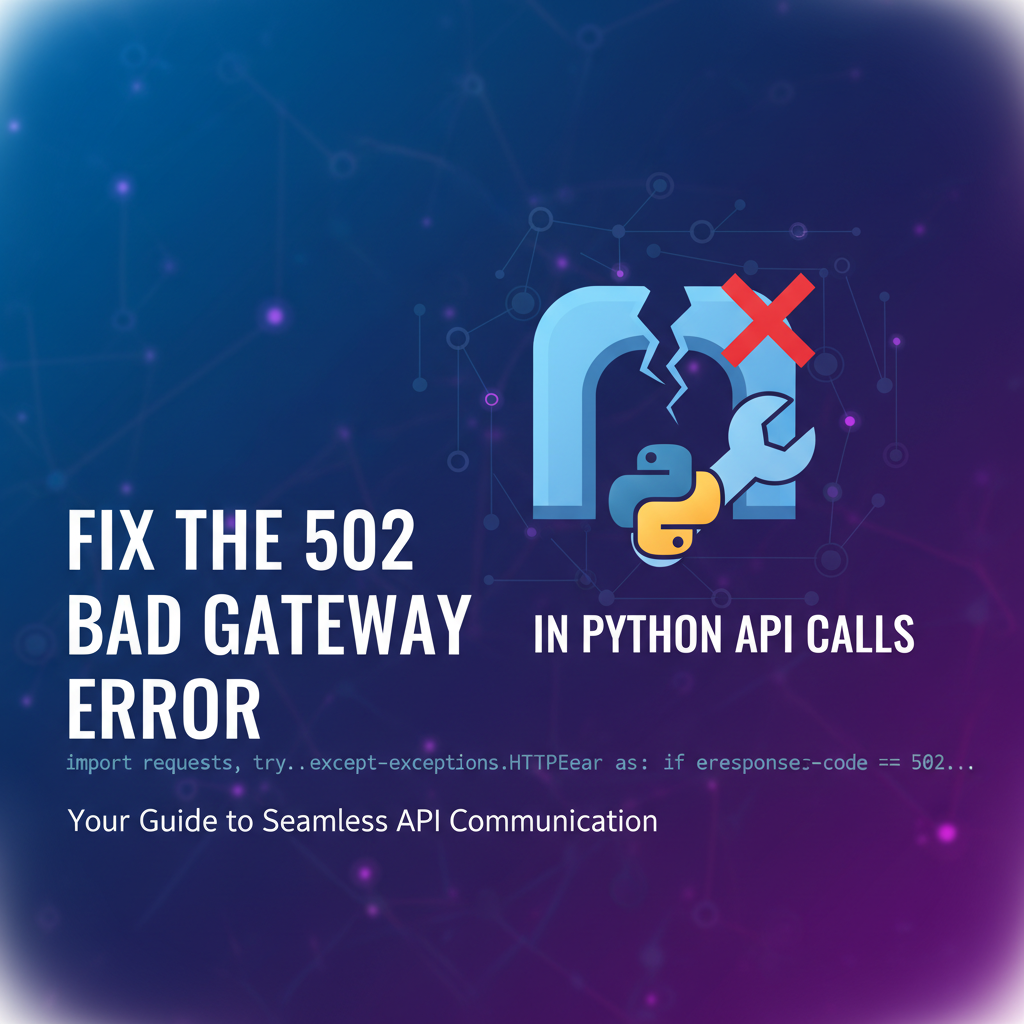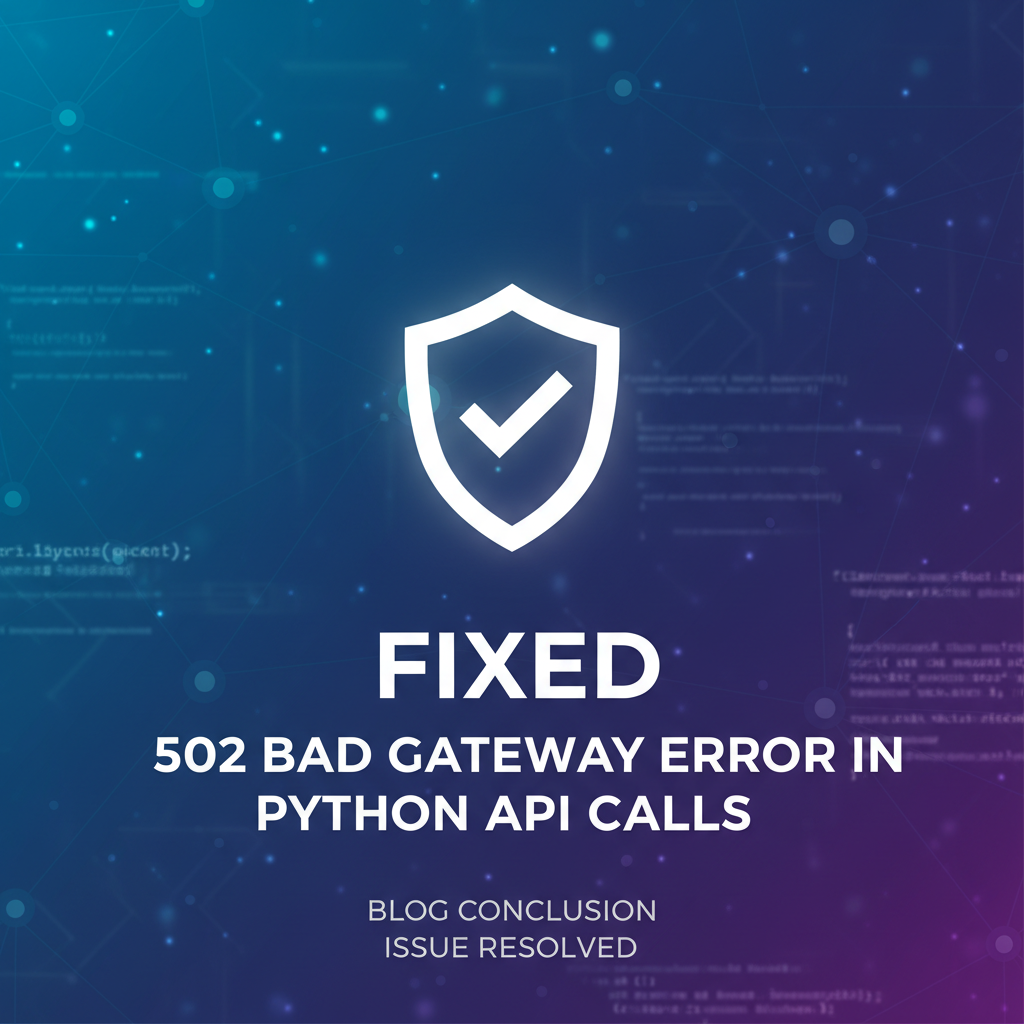Fix the 502 Bad Gateway Error in Python API Calls

Introduction
The 502 Bad Gateway error is one of the most common issues encountered when working with APIs. This error typically occurs when a server acting as a gateway or proxy receives an invalid response from an upstream server. In Python, when making API calls, this error can be particularly frustrating as it can interrupt the flow of your application. This article will delve into the causes of the 502 Bad Gateway error, provide a step-by-step guide to troubleshooting it in Python, and introduce you to APIPark, an open-source AI gateway and API management platform that can help prevent such errors.
Understanding the 502 Bad Gateway Error
Before we dive into the technical details, it's important to understand what the 502 Bad Gateway error actually means. This error occurs when a server acting as a gateway or proxy cannot get a valid response from an upstream server. This can happen for a variety of reasons, including:
- The upstream server is down or not responding.
- There is a network issue between the client and the upstream server.
- The request sent to the upstream server is malformed or invalid.
APIPark is a high-performance AI gateway that allows you to securely access the most comprehensive LLM APIs globally on the APIPark platform, including OpenAI, Anthropic, Mistral, Llama2, Google Gemini, and more.Try APIPark now! 👇👇👇
Troubleshooting the 502 Bad Gateway Error in Python
Step 1: Verify the API Endpoint
The first step in troubleshooting the 502 Bad Gateway error is to verify that the API endpoint you are trying to reach is correct. Double-check the URL and ensure that it is accessible via a web browser or other tools like Postman.
Step 2: Check the Network Connection
Next, ensure that your network connection is stable. You can use tools like ping or traceroute to check the connectivity between your machine and the API server.
Step 3: Inspect the Request
Inspect the request that you are sending to the API. Ensure that it is properly formatted and that all required headers and parameters are included. If you are using Python, you can use the requests library to make HTTP requests and inspect the request details.
Step 4: Use a Proxy
If you suspect that there is a network issue, you can use a proxy to test your API call. This can help isolate the problem and determine if it is related to your network or the API server.
Step 5: Check the API Server Logs
If you have access to the API server, check the server logs for any errors or warnings that might provide clues about the cause of the 502 Bad Gateway error.
Step 6: Implement Error Handling
Implement error handling in your Python code to gracefully handle the 502 Bad Gateway error. This can help prevent your application from crashing and provide valuable information for troubleshooting.
APIPark: An Effective Solution for API Management
One of the best ways to prevent the 502 Bad Gateway error is to use a robust API management platform like APIPark. APIPark is an open-source AI gateway and API management platform that can help you manage, integrate, and deploy AI and REST services with ease.
Key Features of APIPark
- Quick Integration of 100+ AI Models: APIPark offers the capability to integrate a variety of AI models with a unified management system for authentication and cost tracking.
- Unified API Format for AI Invocation: It standardizes the request data format across all AI models, ensuring that changes in AI models or prompts do not affect the application or microservices.
- Prompt Encapsulation into REST API: Users can quickly combine AI models with custom prompts to create new APIs, such as sentiment analysis, translation, or data analysis APIs.
- End-to-End API Lifecycle Management: APIPark assists with managing the entire lifecycle of APIs, including design, publication, invocation, and decommission.
- API Service Sharing within Teams: The platform allows for the centralized display of all API services, making it easy for different departments and teams to find and use the required API services.
How APIPark Helps Prevent the 502 Bad Gateway Error
APIPark helps prevent the 502 Bad Gateway error by providing several key features:
- Load Balancing: APIPark can distribute traffic across multiple servers, reducing the load on any single server and preventing it from becoming overwhelmed.
- Error Handling: APIPark can handle errors and retries, ensuring that your application continues to function even if an API call fails.
- Monitoring: APIPark provides real-time monitoring of API performance, allowing you to quickly identify and resolve issues that could lead to the 502 Bad Gateway error.
Conclusion
The 502 Bad Gateway error is a common issue that can disrupt the flow of your Python application. By understanding the causes of this error and using a platform like APIPark, you can effectively prevent and troubleshoot this problem. APIPark's robust API management features can help you manage your APIs more efficiently and ensure that your application remains stable and reliable.
FAQs
Q1: What is the 502 Bad Gateway error? A1: The 502 Bad Gateway error is a common HTTP status code that indicates that a server acting as a gateway or proxy received an invalid response from an upstream server.
Q2: How can I prevent the 502 Bad Gateway error? A2: You can prevent the 502 Bad Gateway error by using a robust API management platform like APIPark, which provides features like load balancing, error handling, and monitoring.
Q3: What are the key features of APIPark? A3: APIPark offers features such as quick integration of AI models, unified API format for AI invocation, prompt encapsulation into REST API, end-to-end API lifecycle management, and more.
Q4: How can APIPark help me troubleshoot the 502 Bad Gateway error? A4: APIPark can help you troubleshoot the 502 Bad Gateway error by providing features like load balancing, error handling, and monitoring, which can help you identify and resolve issues quickly.
Q5: What is the difference between APIPark and other API management platforms? A5: APIPark stands out from other API management platforms due to its open-source nature, robust feature set, and focus on AI and REST services integration.
🚀You can securely and efficiently call the OpenAI API on APIPark in just two steps:
Step 1: Deploy the APIPark AI gateway in 5 minutes.
APIPark is developed based on Golang, offering strong product performance and low development and maintenance costs. You can deploy APIPark with a single command line.
curl -sSO https://download.apipark.com/install/quick-start.sh; bash quick-start.sh

In my experience, you can see the successful deployment interface within 5 to 10 minutes. Then, you can log in to APIPark using your account.

Step 2: Call the OpenAI API.



